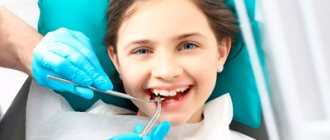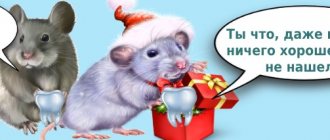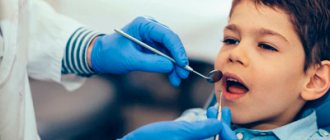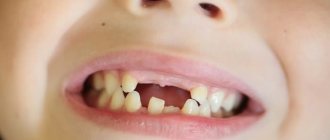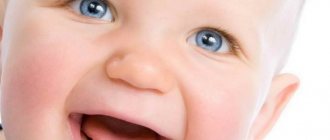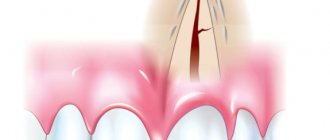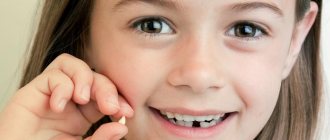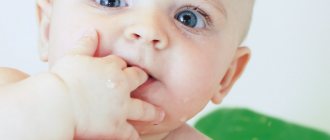There are many misconceptions about whether children's baby teeth hurt. Some parents believe that there is no need to treat these teeth, because they change with age. Others, on the contrary, are convinced that baby teeth require exactly the same amount of care and attention as permanent teeth. Which one is right?
Do baby teeth hurt in children?
First, it’s worth understanding how the dental system develops in children. By the time the baby is born, his mouth is completely missing teeth, which is beneficial for the baby, because his food for the next few months will be breast milk. In addition to the absence of teeth, infants differ from older children in that they have a pronounced sucking reflex. They also have a special type of breathing and a small size of the lower jaw relative to the upper. All these features help infants when feeding on mother's milk.
Infants have no teeth
The process of formation of baby teeth
Starting from the age of 6 months, the child's first teeth erupt. By the age of 2.5 years, the eruption of primary teeth should normally be completed, but all timing is individual. There is a misconception that baby teeth do not have roots. In fact, children's teeth are structured exactly the same as permanent teeth, with the exception of minor differences in structure. The general shape of a baby tooth is similar to that of a permanent tooth: it has a crown, a neck (the transition point between the crown and the root, located at the level of the gums) and a root. Initially, the crown of the tooth erupts into the cavity through the surface of the gum, in this it is helped by the sharp shape of the cusps and cutting edges, as well as intense chewing movements made either when eating or when using a special silicone teether in young children.
Scheme of eruption and loss of baby teeth
Subsequently, over the course of 1.5-3.5 years, the root of each tooth is gradually formed. The period of root formation is followed by a period of rest, when the structure of the tooth remains virtually unchanged. This period lasts on average 3-4 years. Finally, starting from the age of five, one by one, the roots of baby teeth begin to dissolve, giving way to permanent teeth. This process is completely natural and painless if the tooth has not been affected by caries and its complications.
Scheme of eruption of permanent teeth
How to relieve pain if a child has a baby toothache
Before visiting a doctor, it is important to alleviate the baby’s suffering. Painkillers, which are always present in the home medicine cabinet of families with children, are suitable for this. If a 3-year-old child has a toothache, you can give one of these medications in an age-appropriate dosage:
- ibuprofen - the effect occurs after half an hour and lasts 6-8 hours;
- nimesulide - approved from two years of age, valid for up to 12 hours, presented in Nise or Nimesil tablets, however, this remedy is best used on the recommendation of a doctor;
- dental drops – suitable for older children.
Features of the structure of milk teeth
What distinguishes temporary teeth from permanent teeth? First of all, the tooth tissues themselves - enamel and dentin - are much less durable. They contain less mineral matter, which means they are more susceptible not only to abrasion, but also to the carious process. The walls of the crowns and roots of primary teeth are thinner, and the so-called “nerve” inside the tooth (its pulp) occupies a much larger volume. For this reason, caries in children occurs at lightning speed and in most cases is accompanied by inflammation of the nearby pulp.
Structure of a human tooth
Insufficiently thorough individual oral hygiene in children necessarily leads to the formation of caries, which often affects more than one surface of the tooth, but surrounds it literally on all sides.
The root of a baby tooth is distinguished by the fact that it has a very wide opening, the so-called root canal. Due to the large width of the canal, inflammation and microbes are quickly transmitted from the dental pulp to the surrounding tissues - periodontium and jawbone. Thus, periodontitis develops, followed by periostitis. In the most unfavorable cases, the germ of the permanent tooth, which is located directly under the root of the milk tooth, is also affected. The infected germ may subsequently grow into a tooth with defective enamel and dentin, or die completely.
Baby tooth
In this case, the permanent tooth will not erupt at all and the patient will be forced to install orthopedic structures to replace the missing tooth or undergo treatment using orthodontic devices, such as braces.
Child with dental structures
The coronal pulp contains sensory nerves, blood vessels and connective tissue. It is located in the so-called pulp chamber, which has a roof, walls and a bottom. The bottom of the pulp chamber is located at the base of the roots, as well as at the place of their divergence in multi-rooted teeth (this place is called a bifurcation). Milk teeth, unlike permanent teeth, have a very thin bottom of the pulp chamber, as well as multiple small tubules connecting the pulp with the periodontium at the bifurcation. With pulpitis and periodontitis, the infection is often transmitted through these tubules, or the thin bottom is destroyed, and in this case, an extensive bone defect occurs in the area of root divergence, which is an indication for tooth extraction.
Stages of caries development up to pulpitis and periodontitis
So, we found out that temporary teeth have a full root, are capable of becoming inflamed and feel pain when the pulp is damaged, and are also especially susceptible to caries due to low mineralization and relatively small wall thickness. Let's look at some of the reasons why baby teeth may hurt in children.
- Which milk teeth fall out in children: diagram
Baby tooth hurts
Treatment of dental diseases that cause painful symptoms
What measures the dentist will take directly depends on the nature of the problem:
- At the initial stage of caries, you can even do without using a drill, which kids are so afraid of. The doctor simply treats the damaged tissue with fluoride and seals the fissures. If the carious cavity is large enough, you cannot do without removing the dark spot with a drill. Then, after cleaning the “hole,” it is treated with special medicinal compounds and sealed.
- In cases of pulpitis, children rarely have the entire pulp removed. Most often, it is sufficient to simply mummify the nerve. For this purpose, the dentist uses the vital amputation technique. It involves removing only the coronal part of the pulp. The root remains intact. In case of a severely advanced disease, they work with all damaged connective tissue.
- In case of inflammation of the periosteum - periostitis - surgical treatment is performed. The doctor opens the formed abscess and washes its cavity. The child is prescribed anti-inflammatory drugs, physiotherapeutic procedures and rinses are prescribed. It is mandatory to treat the disease that led to the inflammatory reaction.
- An abscess involves draining the abscess and cleaning the root canals. The patient must be prescribed antibiotics. It is very important to block the spread of the abscess at an early stage. Otherwise, it may spread to surrounding tissues. Then the child will have to be hospitalized.
- Gingivitis requires complex therapy. The child undergoes professional oral hygiene and all plaque deposits are removed. Then medications and vitamins are selected. In some cases, physiotherapy is indicated.
- The fistula is opened immediately. The root canals are cleaned and filled. After the inflammatory reaction subsides, a permanent filling is placed.
The sooner the pain in primary teeth is treated, the more comfortable the therapy will be for the patient. Therefore, parents should not expect the disease to go away on its own. Only by taking the child to an appointment with the dentist can they be calm about his health.
Caries of baby teeth
Many parents know that of all foods, most babies prefer sweets. They also know that children do not understand the importance of brushing their teeth and are often lazy or skip this procedure altogether. However, not every adult realizes how insidious these bad habits can be. They are the main cause of the formation of caries in children, which is especially destructive, affecting several surfaces of the tooth at once and quickly spreading deep into the tissues.
Initial caries of primary teeth
In young children, caries often develops as a result of excessive bottle feeding. If the child sleeps restlessly, the mother can give him a bottle with a sweet mixture at night. Thus, throughout the night, sweet food will be present in the child’s mouth, which is quickly decomposed by bacteria. The waste product of these bacteria is an acid that destroys tooth tissue and forms carious defects.
With the development of caries, pain occurs when eating cold and sweet foods, such as ice cream or carbonated drinks. Children under 3-4 years old often cannot point to a specific tooth that is causing them discomfort. However, if you notice that when eating, your child cries, touches his lips or teeth, or refuses to eat, you should examine the oral cavity and consult a dentist.
Without proper care, a child’s baby teeth can simply rot at the root at a fairly early age.
What should you not do if your child has a baby toothache?
If there is a cavity in the tooth, you should never put any medications inside, such as aspirin powder or pain-relieving drops. This can harm the child and lead to poisoning of the body. It is also forbidden to heat a sore tooth, as this can accelerate suppuration.
If the tooth stops hurting, you shouldn’t think that the problem has resolved itself. The acute process has become chronic, the destruction of tissue inside is progressing. There is an infection in the body that can lead to other pathological processes. Even with improvements, a visit to the dentist is mandatory!
Pulpitis of baby teeth
In the absence of timely treatment of caries, inflammation of the pulp or pulpitis develops. In this case, the microbes that initially affected the enamel and dentin reach the nerve, causing intense, long-lasting pain. Often the pain occurs on its own, the child stops sleeping peacefully, cries and complains about his teeth at night. The child’s face in the cheek area may become swollen, and general health may deteriorate.
Structure of a pulpit tooth
In other cases, pulpitis occurs for a long time without pronounced symptoms, but this should not reassure parents, because the affected tooth still requires treatment. You should not wait for the process to worsen; it is preferable to treat a baby tooth when the child has virtually no complaints. This way, the treatment procedure will be calmer, without additional stress for the little patient and his parents, and the doctor won’t have to spend a long time persuading the baby to open his mouth.
Pulpitis of baby teeth
Pain in baby teeth after filling
It would seem that if there is a filling, then there should be no problems. But in practice, pain often occurs precisely in the area of the treated tooth. This is possible if the carious cavity was cleaned poorly, the root canals are not completely closed with a sealing compound, an inflammatory process has begun in the roots, and pulpitis has developed. It also happens that a small patient develops individual intolerance to the filling material installed for him. Regardless of the reason, most often the dentist removes the filling and examines the condition of the dental bottom. First, the doctor takes an x-ray to see if the roots are affected. It is dangerous to endure pain in a filled tooth. The inflammatory process occurring under the filling often spreads to adjacent soft tissues and the jaw bone. This is fraught with serious health problems.
Periodontitis of baby teeth
After prolonged inflammation of the pulp and without treatment, the root/coronal pulp dies. In its place, in the pulp chamber and canals of the tooth, necrotic destroyed tissue remains, abundantly contaminated with pathogenic microorganisms. From the root canal of the tooth, microbes enter the periodontal ligament of the tooth, and from it into the bone, causing destruction and inflammation. A granuloma forms around the root, and fistulas form on the gums in the area of the affected tooth, from which the pus accumulated in the bone is released.
Signs of periodontitis
The tooth changes color from milky white to dark gray. The child stops complaining of pain from eating sweet, cold and hot foods, since with periodontitis the pulp loses sensitivity due to its complete death. Pain occurs when chewing and biting food, as well as when pressing and tapping on the tooth. When the process worsens, the general condition sharply worsens, swelling occurs, and the temperature rises.
The roots of baby teeth affected by periodontitis dissolve quite quickly. Such resorption is not physiological, it occurs untimely and is a consequence of inflammation, and also very often affects the germ of a permanent tooth. Most often, baby teeth with periodontitis must be removed.
Periodontitis in children on the upper jaw
In order to preserve not only milk, but also permanent teeth in a child, it is necessary to promptly detect and treat caries and its complications at all stages, and in some cases, remove teeth that cannot be treated.
Periodontitis of baby teeth
What to do if a 6 year old child has a toothache?
Folk remedies can bring temporary relief. The main thing is that they do not cause an allergic reaction (herbs, honey) and do not lead to gum burns (tinctures, garlic). Dosages should be minimal. Children 6 years and older benefit from rinsing the mouth at intervals of 2-3 hours. The solution (not hot) must be kept in the mouth for up to a minute. Suitable for these purposes:
- saline solution (a glass of water + a teaspoon of salt);
- soda solution (a glass of water + half a teaspoon of soda);
- a decoction of chamomile, sage, lemon balm, oak bark, mint or other medicinal herbs.
So, what to do if your child has toothache? First of all, don't panic! Make an appointment with a pediatric dentist. After taking painkillers and rinsing, the baby will feel better. To prevent the situation from getting worse, offer your son or daughter soft or semi-liquid food, do not give anything cold or hot, and ask him to rinse his mouth with warm water after each meal. These measures are quite enough to survive the period until a visit to the pediatric dentist. Keep calm - and it will definitely be passed on to your child!
Gingivitis in children
Another common cause of oral pain in children is gum disease, or gingivitis. The child cannot always determine what exactly caused the pain - the tooth or the gums. Parents should periodically independently examine the child's oral cavity to assess not only the presence of visible cavities, but also the state of the child's oral hygiene. It is the accumulation of a large amount of soft and hard plaque that causes inflammation of the gums, due to the proliferation of pathogenic bacteria in this plaque.
- At what age do baby teeth fall out?
Gingivitis in children
When examining a child’s oral cavity, you can detect gum redness, swelling, and bleeding. All these are signs of gingivitis, which means you need to consult a dentist to make an accurate diagnosis, identify the cause of the disease and prescribe treatment.
Gingivitis can be caused not only by poor oral hygiene, but also by diseases of the child’s internal organs, vitamin deficiencies and endocrine disorders.
Gingivitis
In addition to treatment, it is necessary to adjust the child’s teeth brushing technique, in which both the dentist and parents should help him. You should also discipline your child and motivate him to brush his teeth regularly, not to be lazy and not to skip brushing his teeth.
Table. Features of different forms of gingivitis.
| Form of gingivitis | Child's age | Appearance | Causes |
| Acute traumatic | Any | Red, swollen, painful gums in one limited area | Accidental mechanical trauma to the gums by foreign objects or hard food |
| Chronic catarrhal | Mainly after teething | Red, swollen, painful, and bleeding gums over the entire jaw or both jaws | Poor and irregular oral hygiene, chronic diseases, weak child immunity |
| Chronic hypertrophic | Teenage years | Enlarged, swollen gums, bleeding, discoloration of gums | Incorrect position of teeth, hormonal changes in the body, endocrine disorders |
| Chronic desquamative | Mainly after 6 years, adolescence | Bright red, smoothed gums with signs of atrophy and multiple erosions | Concomitant skin diseases, allergies to personal hygiene products |
Why do baby teeth hurt in children?
There are quite a few reasons. All of them are associated with various dental ailments. The prerequisites for any oral disease are poor hygiene, consumption of large amounts of sweets, and an unbalanced diet. Let's list the main reasons:
- advanced caries;
- progressive acute pulpitis;
- periodontitis;
- flux;
- erosive damage to enamel tissue;
- gingivitis;
- stomatitis;
- increased sensitivity due to insufficient mineralization.
Unpleasant sensations in the mouth may occur due to the eruption of permanent units. Then the mucous membrane becomes injured and swells. This condition does not require dental treatment. In case of severe pain, inflamed tissues should be treated with special anesthetic gels. A popular cause of childhood toothache is jaw injury. Therefore, if an outwardly painful unit looks absolutely healthy, parents need to clarify whether the child has fallen or hit his face or chin on hard objects.
What should you do if your child has toothache?
If acute pain appears, it is necessary to examine the oral cavity and try to find out the approximate cause of the appearance and nature of the pain, and then give the child an anesthetic that has been approved by a pediatrician specifically for your baby. Under no circumstances should you resort to using remedies recommended by strangers, as each medicine is tolerated differently by individuals and can cause serious complications, including death. Next, you should immediately consult a dentist.
You should not delay treatment, as inflammatory and purulent processes in children develop very quickly, spread to nearby tissues and cause extremely negative consequences.
If a child experiences acute toothache, you should consult a dentist.
If the nature of the pain is unexpressed, periodic, you should schedule a visit to the dentist in the near future as planned. Treatment outside of an exacerbation is better and more effective, so you should not delay seeing a doctor. The health of baby teeth guarantees not only a quiet life for the baby, but also the correct and complete eruption of healthy permanent teeth. After tooth extraction, how long after you can eat, read on our website
How to relieve pain
The first help from you as parents in such situations is to reduce the pain in the child. Trying to cure any diseases of the mouth, gums and teeth at home is simply unsafe; it can lead to very serious consequences. But you can reduce the pain and calm the baby with the help of recommended medications, which it is advisable to always keep in your home medicine cabinet.
Children with toothache can only be given analgesics that are approved for their age. Such remedies can help stop a painful attack, relieve inflammation, and can remove swelling of the cheek and redness of the oral mucosa. You can use the help of such drugs at home, here are some of the effective ones:
- Dantinorm Baby (a remedy for reducing pain and other symptoms during teething);
- Dentinox (a drug for local use with anesthetic, antiseptic and anti-inflammatory effects);
- Kamistad (gel with active ingredients in the form of lidocaine and chamomile). An effective remedy against pain in teeth and gums;
- Children's Nurofen (proven remedy for inflammation and fever, toothache and swollen gums).
BE SURE to carefully read the instructions for any medicine and strictly follow the dosage regimen and age restrictions specified in the description.
Dental status of children
The condition of the oral cavity directly affects the entire body:
- pathological changes can lead to malfunctions of internal organs (kidneys, gastrointestinal tract) and the appearance of diseases;
- with an incorrect bite, breathing through the nose is impaired, which leads to dysfunction of organs and organ systems;
- caries and the complications caused by it cause sore throat and other diseases, the causative agents of which are streptococci, which cause carious changes in the teeth.
The body characteristics of young children and their underdeveloped immune system determine that they are at risk for developing diseases. Since the body is a single interconnected whole, the condition of the oral cavity is given the same close attention as other organs. That is why WHO has proposed that dental examinations be carried out according to a specific schedule. If a child has a toothache, an immediate unscheduled visit to a pediatric dentist is necessary for an examination and prescription of a course of treatment.
Prevention of caries and pulpitis in children
To prevent dental disease in a child, you need to follow a number of rules:
- Bring him in for a dental checkup every 4 months. Convince your child that everyone goes to the doctor, including adults, so that he does not have any fear of dentists.
- Monitor your child's hygiene. Teach him to brush his teeth correctly, change his toothbrush every month, buy only special children's toothpastes: Splat Kids, ROCS Kids, Weleda with calendula, etc.
- Limit your intake of sweets. Include in your diet foods rich in microelements, especially calcium.
- Treat all childhood diseases in a timely manner, bring the little patient to the clinic at the first symptoms of any pathology, without trying to get rid of it with folk remedies.
Lead a healthy lifestyle and become an example for your child. Thanks to this, he will get sick much less often.
What is caries: causes and development factors in children
Caries occurs due to the active proliferation of cariogenic microbes in the oral cavity. Children become infected with them from adults, after which these microorganisms become part of the human microflora. For a number of reasons, caries develops on baby teeth more often than on molars. These reasons include:
- Incorrect and irregular brushing of teeth. The hygienic procedure for cleaning the cavity should be carried out twice a day - in the morning and before bedtime. At the same time, you need to brush your teeth correctly, and not just move the brush from side to side. Parents should teach children regular hygiene and ensure that cleaning is done correctly. Otherwise, caries and other dental pathologies will occur frequently.
- Weak enamel. On baby teeth it is very thin, so they are more vulnerable to external factors, including cariogenic bacteria.
- Poor nutrition. Children often eat sweets, after eating which the rapid spread of cariogenic microbes begins. They feed on carbohydrates and secrete substances that corrode the enamel, disrupt the pH of the oral fluid and leach minerals from the enamel, preventing it from recovering. It becomes soft and loose. It is easier for microbes to destroy its structure and penetrate first into the dentin and then into the pulp.
- Crowded teeth, malocclusion, deep and narrow fissures. If there are many hard-to-reach places in the oral cavity that are difficult to clean from food debris and bacteria, the child often develops interdental and fissure caries. Carious lesions that occur between teeth are one of the main causes of pulpitis.
There are other risk factors for the development of caries in primary teeth: weak immunity, abrasion of enamel, predisposition to dental diseases, etc. Often this pathology occurs due to the impact of several factors on the tooth, the main of which are bacteria and non-compliance with hygiene rules.
Pulpitis during caries does not occur immediately, but only after the pathological process penetrates the dentin and soft tissues inside the tooth. This happens in the fourth stage.
Why carry out prophylaxis if baby teeth fall out?
Prophylaxis reduces the risk of dental disease in permanent teeth in adolescents and children by 80% - this has been proven by many years of practice.
Preventive measures should begin BEFORE the baby is born, starting from the fifth week of pregnancy. Expectant mothers are recommended to adhere to a specially developed method of antenatal caries prevention in children:
- include foods with a high content of calcium and phosphorus in the diet (fermented milk products, seafood);
- take vitamins prescribed by the doctor;
- do not ignore the sanitation of the oral cavity in the second trimester and the treatment of all existing carious teeth.
A pediatric dentist will advise you on how to prevent caries in children, and from the age of three, prevention is carried out in an outpatient clinic. The cost of preventive procedures will be much less than solving dental problems in an older child.


